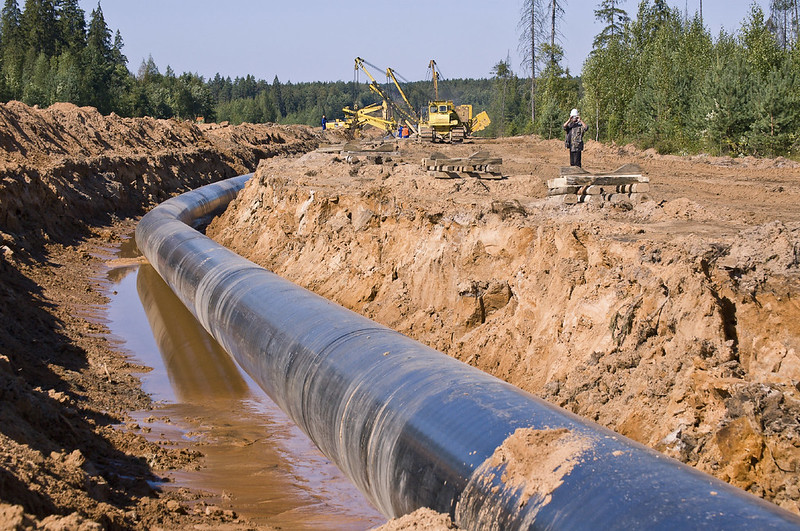Editor’s Note: The Earth is dying and the industrial civilization is killing it. Decades of the environmental movement has not only failed to stop the ecocide, let alone even to slow it down. By the time you finish reading this article, a species will have gone extinct. We’ve tried peaceful negotiations. We’ve lobbied. We’ve protested. We’ve organized non violent direct action. Yet, what seems to be the most effective action is sabotage of infrastructures, be it the attack on Saudi oil wells or on the Niger Delta. DGR is an aboveground organization, yet believes that it is necessary to use any means necessary to bring down the industrial civilization. You can know the difference between an underground and an aboveground organization here.
The following is a communique from an underground group. It is posted from BC Counter Info.
Over the past few months, several sections of the coastal gaslink pipeline have been vandalized. Financially, the consequences of each act were minor: a few holes in the pipeline here, some corroded welding seams there, damaged concrete here. Our goal was to contribute to the small delays in a project that was already well over budget.
- We drilled holes less than a penny wide in a section of pipe that had not yet been lowered into the trench. We covered the holes with fiberglass film, which temporarily prevents leaks in the pipes, but only lasts a few months. We know that welded sections of coated pipe are assessed before being lowered into the trench. After the trench is backfilled, they are tested under pressure. The holes were sealed in the hope that they would pass the first pressure test, but will have to be excavated and repaired before the pipeline is completed. This occurred during the last week of October on section 8 of the pipeline, between Kilometers 610 and 613.
- Between 585 and 588 kilometers of the pipeline, we found a section of pipe that had been dug out, so we damaged the coating at the joints by chipping and sanding it off in less visible places. This coating is needed to protect the pipe from corrosion and rust. We did this in early November. We liked this approach because the damage is not visible, but can still have a significant long-term structural impact if corrosion and rust show up, so it will need to be fixed.
- We drilled very small holes and filled them this time with an epoxy putty, somewhere between Kilometers 605 and 608 of the pipeline route (that’s in section 8.) We did this in the second week of November. We weren’t sure if the sealant would withstand the pressure test, but decided it was worth a try since this sealant is easier to source and use than the fiberglass coating.
- At the end of November, we drilled and filled holes in the pipe string before it would be lowered into section 6 of the pipeline between Kilometers 486 and 489.
- In early December, we chipped and busted the welds on a section of pipe that had not yet been lowered into the trench between Kilometers 606 and 609.
- We damaged the protective coating on a section of pipe by chipping and grinding, and chipped a welded seam on several sections of pipe before they were backfilled between Kilometer 377 and 380 of section 5 of the pipeline. This work was performed in early January.
- Near Kilometer 27 of North Hirsch forestry road we damaged welds and coating on a pipe section in the middle of January.
- We poured hydrochloric acid on the concrete pipes we knew were meant for the tunnel under Wedzin Kwa and used a concrete drill inside the pipe to weaken them even further. The concrete pipes are designed to protect the pipe itself from the pressure of the surrounding soil. Given the heightened security and surveillance of concrete pipe storage, we can’t say when this happened.
- In early December, we grinded and chipped the coating on the welded seams of the pipe sections between Kilometers 598 to 601.
- In mid February, we scraped and chipped large portions of the pipe coating of the string between Kilometers 626 and 629.
Or is that in fact what happened? Only some of these activities have actually taken place. We waited to share this information all at once, complete with some additional false reports, so the only way to know where repairs are really needed is to excavate and re-examine all the above-mentioned pipes. Cracked concrete or rusted and patched pipes can lead to small leaks and large-scale spills, which is why every action, whether genuine or falsified, is being brought to the attention of the public long before the pipeline is operational.
While we would prefer to write only completely honest report backs, we also believe that we should be resourceful and use every means at our disposal to delay construction as best we can. We apologize to those involved in the struggle for not being able to give you an accurate picture of what we have really accomplished. CGL we wish you all the best in your treasure hunt.
Banner “construction of the gas pipeline” by npcaonline is licensed under CC BY 2.0.


Any means necessary to protect and restore native ecosystems and species, yes. But you also have to be strategic and consider the big picture. For example, if shutting down a pipeline permanently were to cause a major backlash against not only environmentalists, but more important against the natural environment, that backlash would likely cause even more destruction and killing, and the action would be a failure. This is exactly why the police state uses agents provocateurs against demonstrations.